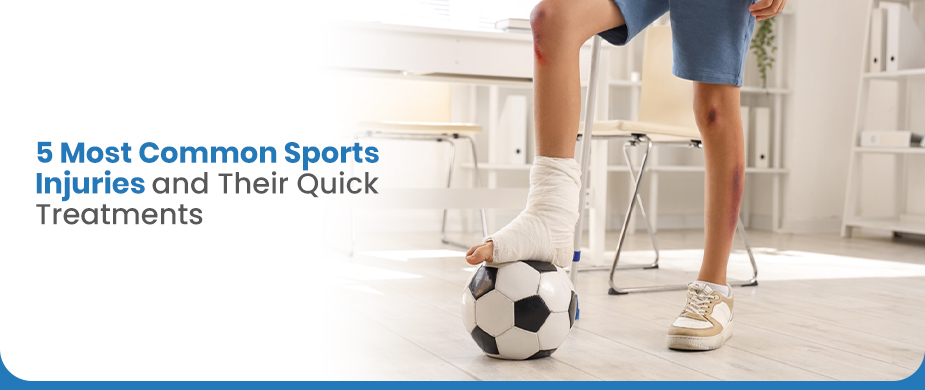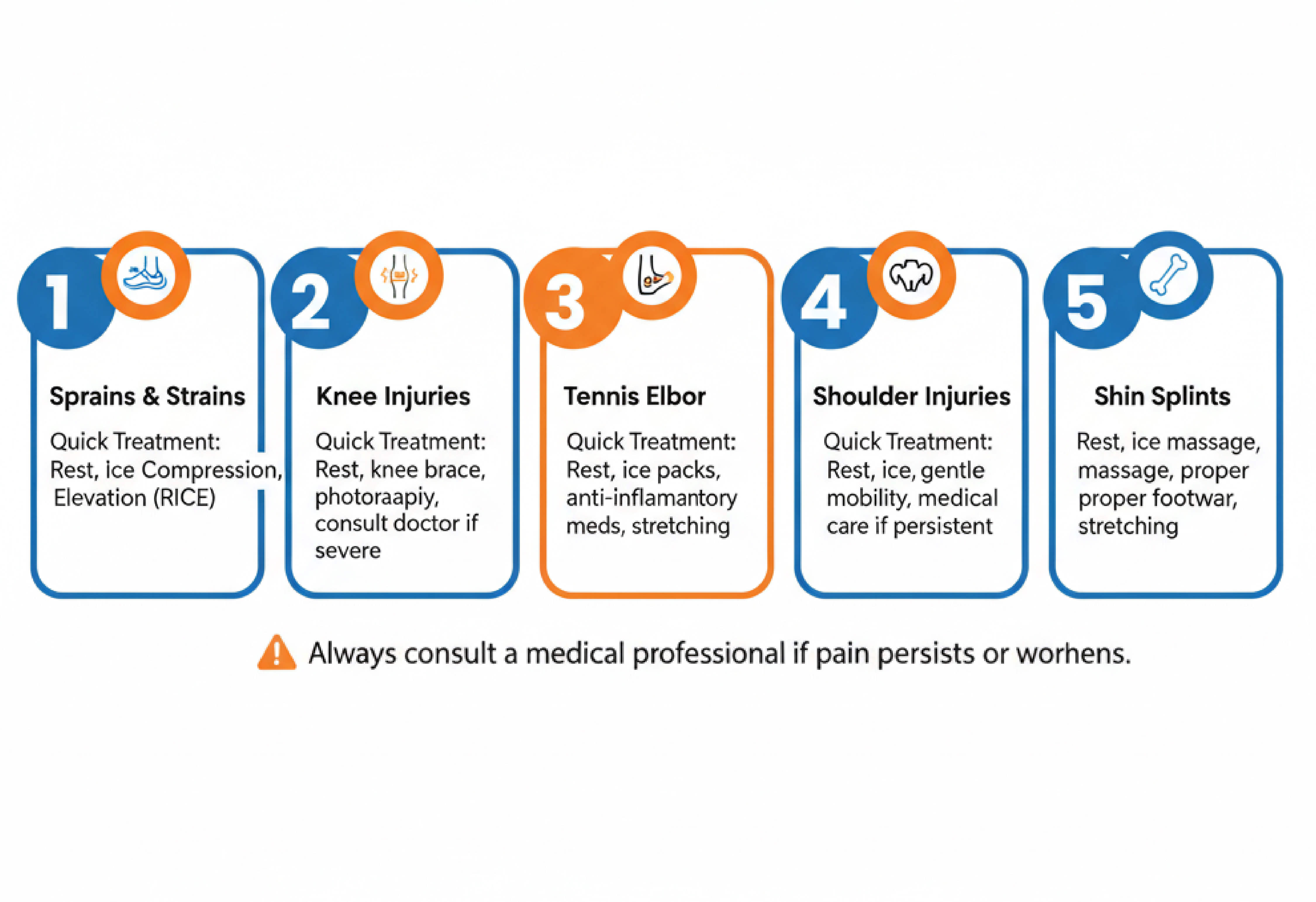
Book an Appointment
Call Us011408468355 Most Common Sports Injuries and Their Quick Treatments
From childhood, you must have played your favorite sports, such as running across fields to get that adrenaline rush after scoring a goal. And like you, everyone should enjoy the joy of sports, because it's a cheaper way to keep you healthy, active, and full of life.
However, let’s be honest, with every sport comes the risk of sports injuries. Twisted ankles, sore knees, or that sudden shoulder pull. And if you are a sports person, you might have also probably experienced one of these at some point.
There is no denial in the fact that sports will always challenge your body, but if you know the right sports injury treatments, you can be ahead of your game. Read this blog to know the common sports injuries and ways to treat them quickly so that you keep playing strong, safely, and fearlessly.

The 5 Common Types of Sports Injuries & Their Quick Treatments
There are many types of sports injuries, and some common ones are:
1. Bone Fractures
A bone fracture indicates a break or crack in your bone. Sometimes, due to injury, the bone may poke through the skin, which is serious. The bone fracture can happen suddenly if you:
- Fall hard or get hit (also known as an acute fracture)
- If you repeat the exact movement a lot (also known as a stress fracture)
How to treat a bone fracture: Follow the following steps for the quick treatment:
- First, do not move the broken part.
- Apply ice to reduce swelling.
- Keep the limb still by splinting it.
- Go to a doctor immediately.
- As per the advice, get your X-rays done.
- Follow your treatment based on the results.
Which sports can cause bone fractures? Contact sports like basketball, football, and ice hockey
2. Bursitis
It happens when small fluid-filled sacs known as bursae (which cushion your joints) get irritated and inflamed. This generally happens due to repeated pressure or overuse, leading to joint pain and swelling.
How to treat bursitis: Follow the following steps for the quick treatment:
- Do not move the affected joint and avoid activities to reduce pain.
- Use ice packs to decrease swelling.
- Take anti-inflammatory medicines after a doctor’s consultation.
- Seek physical therapy if needed.
Which sports can cause bursitis? Sports involving repetitive motions, such as running, tennis, and golf.
3. Concussions
A concussion is a mild brain injury. It can happen due to a hit to the head or body that shakes the brain inside the skull. This can lead to confusion, headache, dizziness, or memory problems.
How to treat concussions: Follow the following steps for the quick treatment:
- Rest is very crucial.
- Do not engage in physical and mental activities until symptoms improve.
- Visit the doctor right away for evaluation.
- Follow their advice before returning to sports.
Which sports can cause concussions? Contact sports like boxing, martial arts, wrestling, field hockey, and basketball.
4. Contusions/Bruises
Contusions are bruises, because of bleeding under your skin. They can happen due to the direct blow or impact that breaks blood vessels under the skin, leading to discoloration and pain.
How to treat Contusions: Follow the following steps for the quick treatment:
- Apply ice soon after the injury to minimize swelling and pain.
- Get a proper rest to protect the area from further impact.
- Lift the injured part if possible.
- Contact your doctor if pain or swelling worsens.
- Follow their advice before returning to sports.
Which sports can cause contusions? Ice hockey, snowboarding, skiing, skateboarding, baseball, and cycling.
5. Joint Dislocation
It happens when bones in a joint get pushed out of their normal position. This happens due to a sudden, forceful impact or fall. It leads to severe pain, swelling, and inability to move the joint properly.
How to treat joint dislocation: Follow the following steps for the quick treatment:
- Do not attempt to pop the bone back yourself.
- Do not move the joint.
- Seek immediate medical help.
- A healthcare professional will realign the joint and may use a sling, splint, or physical therapy afterward.
- Follow their advice for a quick recovery.
Which sports can cause contusions? Snowboarding, skiing, skateboarding, baseball, cycling, and combat sports.
Some Other Types of Sports Injury Are
- Muscle strains: When muscle or tendon fibers stretch or tear. This leads to pain and restricted movement.
- Sprains: Ligaments (connect bones to other bones) stretch or tear, often in ankles or wrists. This leads to swelling and tenderness.
- Tendinitis: Tendons (tissue that attaches muscle to bone) become inflamed from overuse. This causes pain near joints.
Common Sports Injury Symptoms
The common sports injury symptoms are:
- Bruises
- Color changes
- Visible swelling
- Bone deformity
- Movement difficulty
- Putting on weight in the affected part
Which Body Parts Get Injured the Most in Sports?
Certain body parts are more likely to get injured during sports than others, such as:
- Shoulder joint
- Leg muscles
- Knee joint
- Head
- Elbow joint
- Ankle joint
- Achilles tendon (connects your calf muscles to your heel bone)
Risk Factors For Sports Injury
The following factors can increase your risk of sports injury:
- Playing aggressive contact sports
- No proper warming up or stretching
- Starting at an intensity level that your body is not trained for
- Not wearing the right sports gear
How to Diagnose Sports Injuries?
For the proper sports injury diagnosis, consult your doctor, and they can recommend the following imaging tests:
- X-ray
- CT scan
- MRI
Your doctor will ask about what happened at the time of the injury and how it feels when they touch it.
Conclusion
Sports injuries don’t mean that you have to stop playing. All you need is the right care and treatment to bounce back and get back in the game. The real key is practicing prevention habits: wearing the right gear, warming up properly, and using the right sport techniques. If an injury happens, contact your doctor immediately to get proper help quickly.
 By -Dr Aaksha Shukla |
September 20, 2025 | 9 Min Read
By -Dr Aaksha Shukla |
September 20, 2025 | 9 Min Read
Brain Health at Every Age: Preventive Neurology Tips
International Patient Guide: Visiting India for Neuro & Spine Treatments
Robot-Assisted & Navigation-Guided Surgery: Safer Brain & Spine Procedures
Sports Injury Recovery: How Arthroscopy Helps You Heal Faster?
How Deep Brain Stimulation (DBS) Helps in Parkinson’s & Tremor Control
Early Warning Signs of a Brain Tumour & When to See a Neurosurgeon
Signs of a Stroke: When to Seek Emergency Neuro Care
Best Neurosurgery Hospitals in Delhi NCR: A Detailed Guide
Minimally Invasive Spine Surgery: Benefits, Cost & Recovery
Best Tips for Sports Injury Recovery
Guide to Stroke Prevention and Recovery
How to Manage Parkinson’s Symptoms Effectively
Traumatic Brain Injury: Symptoms, Causes, and Treatments
10 Superfoods That Boost Your Brain Power
10 Early Warning Signs of Brain Stroke Everyone Should Know
12 Everyday Habits That Damage Your Spine
Brain Stroke: Causes, Warning Signs & Emergency Treatment
10 Early Symptoms of Brain Tumor You Should Never Ignore

